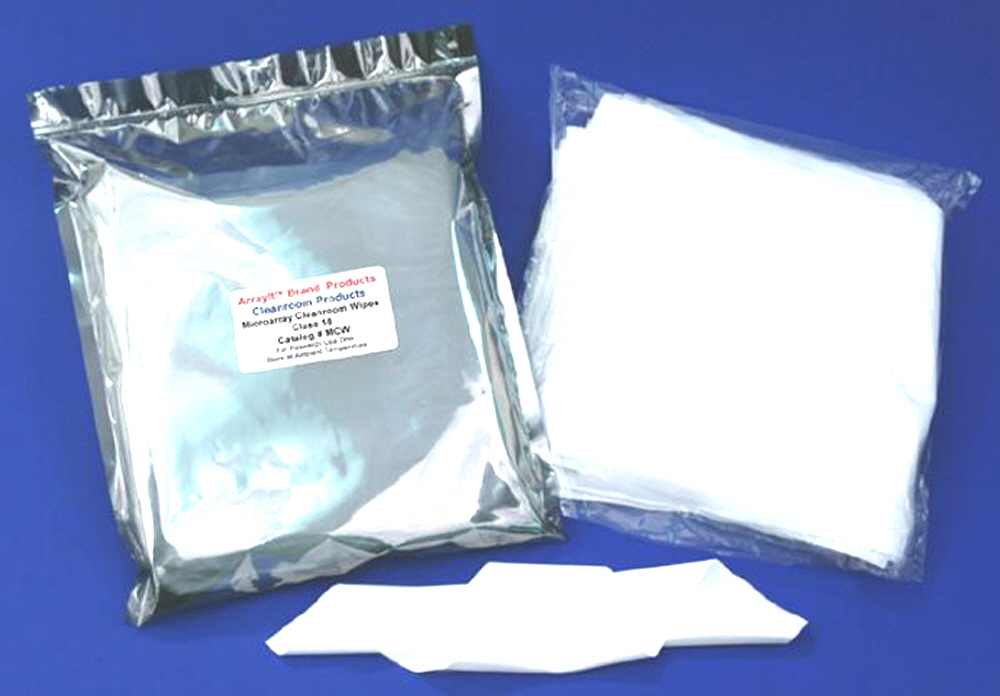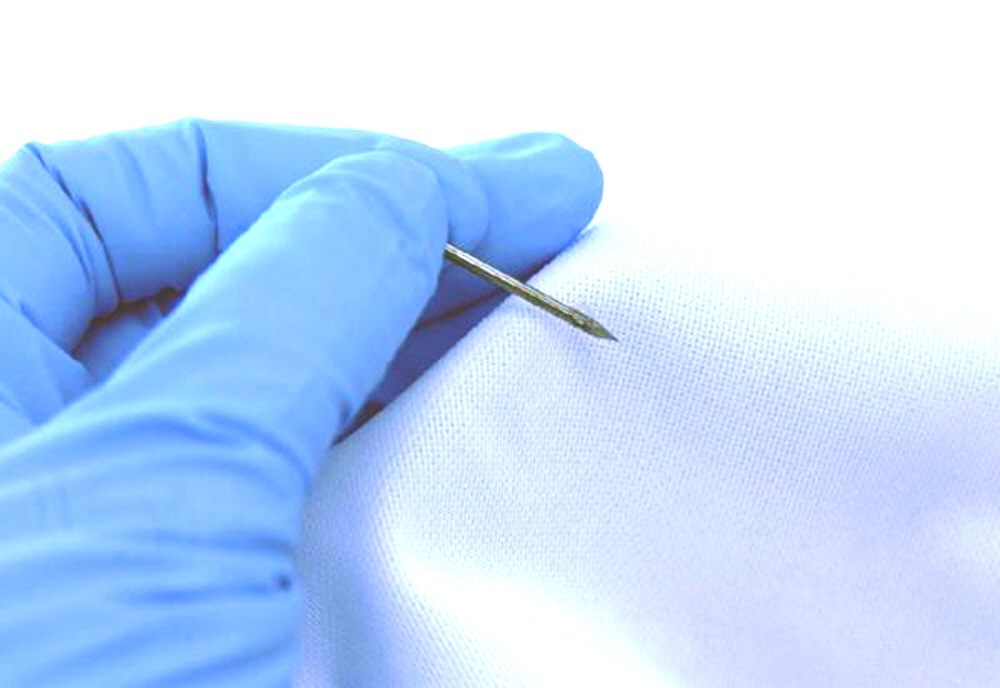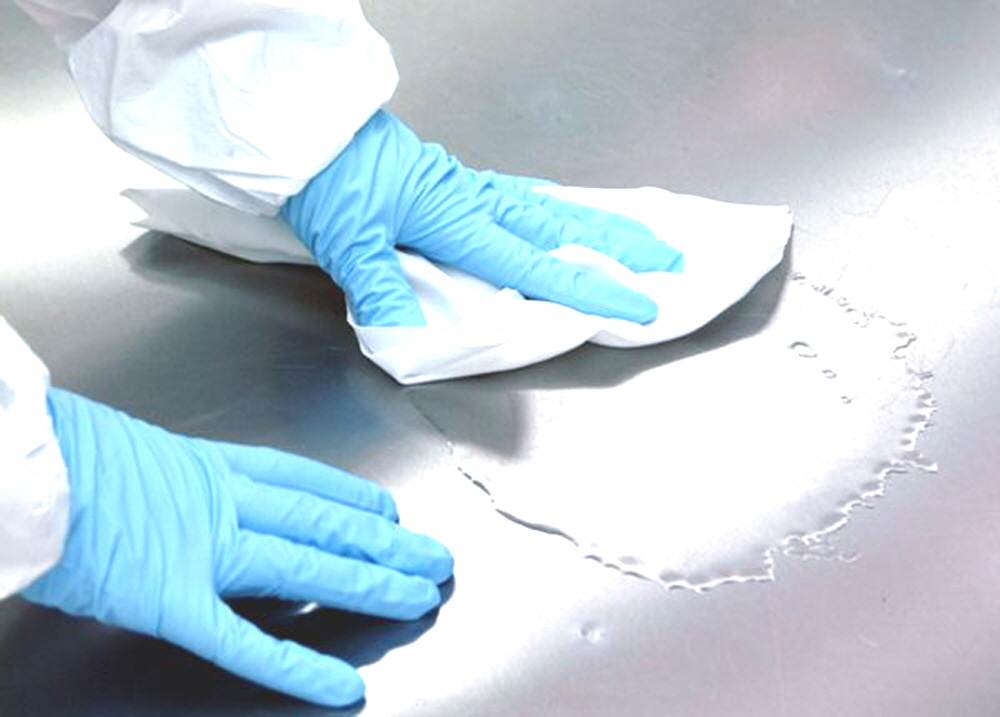Cleanroom Wipes
Data Sheet
![]() Shop this product in our online store
Shop this product in our online store
Cleanroom wipes with polyknit composition and heat-sealed edges for exacting microarray cleanroom applications in class 1, 10, 100 and 1,000 facilities. Cleanroom wipes are essential for microarray manufacturing and other applications that require particle- and lint-free laboratory wipes. Ideal for removing topical contaminants from microarray instruments, computer screens and other exacting equipment, available as non-sterile and sterile wipes for research, microarray life sciences, diagnostics, healthcare and semi-conductor applications.
Products - Microarray Cleanrooms - Cleanroom Wipes

Arrayit offers the market’s finest class 10 cleanroom wipes with polyknit composition and heat-sealed edges for microarray cleanroom and other exacting life sciences, medical diagnostics, microelectronics and industrial manufacturing applications.
Table of Contents
- Introduction
- Quality Control
- Product Description
- Technical Note
- Technical Assistance
- Short Protocol
- Complete Protocol
- Recommended Equipment
- Troubleshooting Tips
- Ordering Information
- Warranty
Introduction
Congratulations on taking a big step towards improving the economies of scale, quality and speed of your microarray cleanroom research. This booklet contains a complete set of illustrations and protocols outlining the steps and principles needed to use ArrayIt® Microarray Cleanroom Wipes (MCW) and Microarray Cleanroom Wipes Sterile (MCWS).
Quality Control
Arrayit assures the performance of this product. The finest scientific research went into the development of this product. Rigorous quality control monitoring on a lot-by-lot basis guarantees that these cleanroom wipes conform to the highest cleanroom industry standards.
Product Description
Arrayit's ArrayIt® Microarray Cleanroom Wipes (MCW) provide the highest quality polynit cleanroom wipes at an affordable price. All of our cleanroom wipes are manufactured in state-of-the art class 10 cleanrooms. Cleanroom manufacture eliminates contamination of the wipes with particulates, proteases, nucleases and other contaminants that impair the quality of microarray experimentation observed if non-cleanroom wipes are used. Compare our cleanroom wipes with traditional laboratory wipes and you will see the difference.
Users will appreciate the following features of Microarray Cleanroom Wipes (MCW):
- Manufactured in state-of-the-art class 10 cleanrooms
- Free of particulates, proteases and nucleases
- Ultra-low emission of volatile organics
- Convenient 9” x 9” size (22.9 x 22.9 x 1 mm)
- Polyknit composition prevents fiber shedding
- Heat sealed edges prevent fraying
- Bright white fabric assists in the identification of spills and residues
- High absorbency fabric maximizes cleaning effectiveness
- Use for cleaning substrates, pins, cassettes, and other microarray implements
- Use for packaging and protecting fragile microarray products
- Compatible with all microarray cleanroom environments
- Ideal for life sciences, medical diagnostics, microelectronics and manufacturing
- Vast improvement over traditional laboratory and cleanroom wipes
- Based on years of intensive microarray cleanroom R&D
- Durable and chemically-resistant composition
- No tearing with normal use
- Affordable price of 65 cents per wipe
- 150 wipes per package
- Anti-static packaging eliminates electrostatic contamination
- Dual packaging allows easy surface de-contamination prior to use
- Can also be used in traditional, non-cleanroom laboratories
- Disposable
- One year shelf life at room temperature
- Available in non-sterile (Cat. MCW) and sterile (Cat. MCWS) configurations
Technical Note
Federal Cleanroom Standard 209E defines and evaluates cleanrooms based on the number of particles of 0.5 µm diameter or larger present per cubic foot of cleanroom air, and those same standards are used to benchmark Arrayit’s microarray cleanrooms and cleanroom products. Class 1, 10, 100, 1,000 and 10,000 cleanrooms contain fewer than 1, 10, 100, 1,000 and 10,000 particles/ft3, respectively. ArrayIt® Microarray Cleanroom Wipes (MCW) are manufactured and packaged in class 10 cleanrooms. The ambient air in a traditional research laboratory contains up to 1,000,000 particles/ft3 depending upon the facility.

Figure 1. Microarray Cleanroom Wipe (MCW) for pin cleaning. Shown is a 9” x 9” Microarray Cleanroom Wipe being used to remove residual water from the tip of a Stealth Micro Spotting Pin (SMP3) following sonication. Optimal Micro Spotting Pin care and use requires wipes that are free of organic and particulate contaminants, and Microarray Cleanroom Wipes meet these requirements. Wipes can be used for pin care in both cleanroom and traditional laboratory settings.

Figure 2. Microarray Cleanroom Wipe (MCW) for spill containment. Shown is a 9” x 9” wipe being used to soak up a buffer spill on a stainless steel cart in a class 1 microarray cleanroom. Cleanroom use often requires routine cleaning or spill containment, and Microarray Cleanroom Wipes (MCW) work well for these purposes. Sterile Microarray Cleanroom Wipes (Cat. MCWS) are available for specialized applications.
Short Protocol (Steps 1-7)
1. Remove the Microarray Cleanroom Wipes (MCW or MCWS) from shipping box.
2. Decontaminate anti-static bag topically with 100% ethanol.
3. Decontaminate anti-static bag with particle-free forced air (optional).
4. Transport the Microarray Cleanroom Wipes (MCW or MCWS) into cleanroom vestibule.
5. Remove and discard the silver anti-static package.
6. Transport the Microarray Cleanroom Wipes (MCW) into the cleanroom.
7. Cut open the plastic package carefully and use wipes as needed.
Complete Protocol (Steps 1-7)
1. Remove the Microarray Cleanroom Wipes (MCW or MCWS) from shipping box. The outer packaging material is a silver-colored anti-static bag that prevents electrostatic and particle contamination of the wipes. Do not open the anti-static bag until inside the vestibule or changing room of a cleanroom. Microarray Cleanroom Wipes also provide an excellent source of lint-free wipes for many non-cleanroom applications including the maintenance of microarray pins and printheads, microarrayers, scanners, microscopes, and other scientific instrumentation and equipment. For non-cleanroom applications, open the anti-static package and remove the inner plastic package that contains the cleanroom wipes. With a scissors, cut the plastic package carefully, making certain not to damage the wipes. Use as needed.
2. Decontaminate anti-static bag topically with 100% ethanol. Cover your hands with Microarray Cleanroom Gloves, wet a cleanroom wipe liberally with 100% ethanol, and wipe the outside of the silver anti-static package to remove particulates and other forms of debris. Do not open zip-lock package until inside the cleanroom vestibule or changing room.
3. Decontaminate anti-static bag with particle-free forced air (optional). For Class 1, 10, 100 and 1,000 cleanrooms, the anti-static package should also be decontaminated with a filtered source of pressurized, oil-free air prior to entering the cleanroom vestibule or changing room. Forced air removes additional contaminating particles prior to entering the cleanroom facility. Make certain to wear Microarray Cleanroom Gloves at all times when handling the decontaminated, anti-static packaging material. Failure to wear suitable hand protection will introduce hand oils, ribonucleases, and other contaminants into the cleanroom.
4. Transport the Microarray Cleanroom Wipes (MCW or MCWS) into cleanroom vestibule or changing area. Make certain to remove shoes, sweaters, and other non-essential clothing prior to entering the cleanroom. Microarray Cleanroom Gloves or equivalent hand coverings should also be worn at all times when inside a cleanroom. Step into a Microarray Cleanroom Suit, making sure that the appropriate cleansuit size (S, M, L, and XL) has been selected. Close the cleansuit by zippering the front completely, and make certain that the elastic wrist and ankle bands are positioned properly. Face shields and other respiratory devices can also be worn to provide additional containment against contamination.
5. Remove and discard the silver anti-static package. Open the zip-lock top of the silver anti-static package, remove the inner plastic package that contains the Microarray Cleanroom Wipes and set it aside. Discard the anti-static package in a cleanroom waste receptacle located in the cleanroom vestibule or changing room. Do not transport the outer packaging material into the main cleanroom space.
6. Transport Microarray Cleanroom Wipes (MCW) into the cleanroom. Transport the plastic packaging containing the wipe into the main cleanroom space.
7. Cut open the plastic package carefully and use wipes as needed. Carefully cut open the plastic packaging material using a sharp pair of cleanroom scissors, making certain not to cut the cleanroom wipes. If the cleanroom wipes are cut accidentally, remove them from the cleanroom immediately, as the frayed edges can emit contaminating fibers. Place the opened plastic package on a benchtop or cleanroom shelf and use as needed to clean microarrayers, scanners, pins and printheads. Wipes can also be used to contain minor spills, and for topical cleaning of benches and other cleanroom surfaces. Microarray Cleanroom Wipes are disposable, and soiled wipes can be discarded in the regular cleanroom waste containers. Never expose the polyknit material to sources of open flame.
Recommended Equipment
Microarray Cleanroom Suits
Microarray Cleanroom Gloves
Super Microarray Substrates
Stealth Micro Spotting Device
SpotBot® 2 Personal Microarrayer
High Throughput Wash Station
Microarray High-Speed Centrifuge
Microarray Hybridization Cassette
Troubleshooting Tips
Fiber shedding
- Tearing of polyknit material. Avoid sharp objects and edges, and never cut a wipe with a scissors or any other cutting implement.
Insufficient absorbency
- Use multiple wipes for spill.
- Wring wipes during cleaning procedure to restore absorbency.

